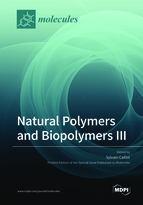Natural Polymers and Biopolymers III
A special issue of Molecules (ISSN 1420-3049). This special issue belongs to the section "Macromolecular Chemistry".
Deadline for manuscript submissions: closed (31 March 2023) | Viewed by 37287
Special Issue Editor
Interests: green and sustainable chemistry; building-blocks from biomass; biobased monomers and polymers
Special Issues, Collections and Topics in MDPI journals
Special Issue Information
Dear Colleagues,
The past 20 years have seen a booming number of articles and reviews describing the use of bio-resources as a starting point for original polymer chemistry. Indeed, the use of renewable resources could help the chemical industry to solve some of the current challenges of our society: global warming and limited fossil resources. Hence, the latest developments not only have created a library of polymeric materials exhibiting a wide range of properties to fulfill the requirements of various industrial applications, but also have improved our knowledge and understanding of the structure and reactivity of the complex biomass. Additionally, these biopolymers could allow addressing unmet needs and obtaining new properties that cannot be achieved with petrobased chemicals. They could also help avoid the use of harmful substances, thus contributing to restoring chemical industry’s sustainability.
This Special Issue on "Natural Polymers and Biopolymers" is prompted by the increasing attention that the field of “green polymers” is receiving. It will present cutting-edge research works focusing on the use of bio-resources for polymeric materials and will show how natural polymers and biopolymers, with their interesting and original properties, are destined to replace and outperform oil-based polymers.
Dr. Sylvain Caillol
Guest Editor
Manuscript Submission Information
Manuscripts should be submitted online at www.mdpi.com by registering and logging in to this website. Once you are registered, click here to go to the submission form. Manuscripts can be submitted until the deadline. All submissions that pass pre-check are peer-reviewed. Accepted papers will be published continuously in the journal (as soon as accepted) and will be listed together on the special issue website. Research articles, review articles as well as short communications are invited. For planned papers, a title and short abstract (about 100 words) can be sent to the Editorial Office for announcement on this website.
Submitted manuscripts should not have been published previously, nor be under consideration for publication elsewhere (except conference proceedings papers). All manuscripts are thoroughly refereed through a single-blind peer-review process. A guide for authors and other relevant information for submission of manuscripts is available on the Instructions for Authors page. Molecules is an international peer-reviewed open access semimonthly journal published by MDPI.
Please visit the Instructions for Authors page before submitting a manuscript. The Article Processing Charge (APC) for publication in this open access journal is 2700 CHF (Swiss Francs). Submitted papers should be well formatted and use good English. Authors may use MDPI's English editing service prior to publication or during author revisions.
Keywords
- Biopolymers
- Bio-based polymers
- Biomass
- Biodegradation
- Chemical functionalization
- Crosslinking
- Mechanical properties
- Natural polymers
- Recycling
- Renewable resources
- Structure characterization
- Thermosets
- Thermal properties
- Toxicity and Environmental assessment
Related Special Issues
- Natural Polymers and Biopolymers II in Molecules (27 articles)
- Natural Polymers and Biopolymers in Molecules (10 articles)







